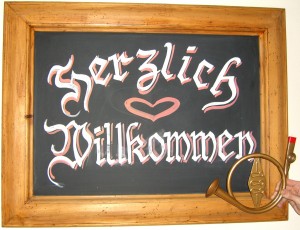 Herzlich Willkommen the sign said at our restaurant of choice the evening we arrived. Corzoo translated for us all, in case we weren’t sure what it said. A Heartfelt Welcome!
Herzlich Willkommen the sign said at our restaurant of choice the evening we arrived. Corzoo translated for us all, in case we weren’t sure what it said. A Heartfelt Welcome!
We had arrived in a blisteringly hot Vienna.
“Wien!” said Corzoo with delight as we wandered the old narrow streets towards our first destination. He now would only refer to Vienna using the German name for it. “Wien! I feel like it is the best and most beautiful city in the world!”
“It is indeed a very special place, Corzoo. But I feel like cities are a bit like people. They each have something unique to offer, being shaped by their own particular geography, age, and history. Each city has a personality, sometimes multiple personalities! There can be things we love about them, and other things that we could do without…” I was beginning to ramble, a little delirious from the long trip.
“Well, I have a feeling that Wien and I are going to get along splendidly,” replied Corzoo. “How could I not get along with a city that has street names of Brucknerstrasse! Beethovenplatz! Schubertring! Operngasse!”
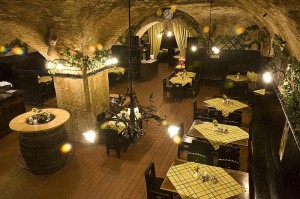 Corzoo had been eager to dash out the door of the hotel as soon as we arrived, ready to absorb everything about this city that oozed music even onto its street signs. However, when arriving in a hot city after many hours of travel, the first priority is to shower and have a little rest. Second on the list is to have a delicious meal, preferably a sampling of the local cuisine! That is exactly where we were headed. Down two levels beneath the street we went, into a restaurant of typical Austrian fare. It was a large, old wine cellar and a wonderfully cool respite from the heat of the streets above. We delighted in the atmosphere and, between the five of us in our little outing, we sampled the schnitzel, the goulash, the roast pork and the strudel.
Corzoo had been eager to dash out the door of the hotel as soon as we arrived, ready to absorb everything about this city that oozed music even onto its street signs. However, when arriving in a hot city after many hours of travel, the first priority is to shower and have a little rest. Second on the list is to have a delicious meal, preferably a sampling of the local cuisine! That is exactly where we were headed. Down two levels beneath the street we went, into a restaurant of typical Austrian fare. It was a large, old wine cellar and a wonderfully cool respite from the heat of the streets above. We delighted in the atmosphere and, between the five of us in our little outing, we sampled the schnitzel, the goulash, the roast pork and the strudel.
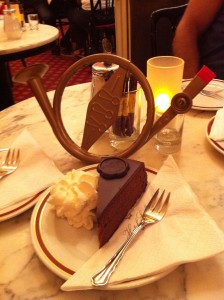 Satisfied to have experienced some traditional Austrian flavor, off we went to finish our meal at the Hotel Sacher with Sachertorte, a famous chocolate cake with a subtle apricot filling. A must-have in Vienna!
Satisfied to have experienced some traditional Austrian flavor, off we went to finish our meal at the Hotel Sacher with Sachertorte, a famous chocolate cake with a subtle apricot filling. A must-have in Vienna!
In our wanderings that evening, Corzoo rode only halfway in my bag, so as to be able take in the sights and sounds of the evening. Since this was the older part of the city, the streets were stone-paved and narrow, and the buildings were grand and ornate, with impressive iron gates and tall, elaborate wooden doors.
We were passing by several shop windows when…
“AAAACCCCKKKK!!” Corzoo let out a shriek.
“What is it? What’s wrong?” I asked, following his gaze.
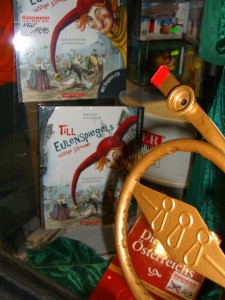 There, displayed in a window of a closed bookshop was a colorful book with a picture of a funny little prankster on it.
There, displayed in a window of a closed bookshop was a colorful book with a picture of a funny little prankster on it.
“Holy Richard Strauss!” he exclaimed. “It’s Till Eulenspiegels Lustige Streiche! Shall I translate…?”
“I think I might know this one, Corzoo. Till Eulenspiegel’s Merry Pranks! Play it for us now if you wish – there is hardly anyone around to bother at this hour.”
Corzoo launched into the main horn solo in the beginning of the Strauss tone poem just after the shimmering strings have played their introduction.
It sounded like a very good joke indeed, full of Till’s personality. A few passersby offered some scattered applause and smiled at the glee with which the young musician played. Laughing after Corzoo’s round of deep, dramatic bows, we continued our stroll.
Soon we came to Michaelsplatz, one of the many beautiful plazas and squares in the city.
I heard my little friend’s buzzy voice. “Look over here! A house beneath the street!” There, in the middle of the plaza, was a large hole in the ground with a guardrail around it. It was an excavation of ancient Roman ruins displayed for all to see.
We walked slowly around the large dig. We were looking down as if standing on the roof of a two or three story house. The roof was mostly gone but the walls stood. We could see the doorways, the tiny ancient windows, and the layout of the rooms. Above the house, we could also see remains of an old water system that had been built over this spot centuries later. Then we could see the old foundations of other more recent buildings.
“Stratification!” cried Corzoo.
“What?” we said in unison.
“Shall I define stratification for you?”
“Yes, please!” we said.
Corzoo raised one valve in a professor-ly way and started in on his explanation: “It is a term used in geology and archaeology to mean the layers in the ground or in rock or in other materials that give us a sense of chronology and the passage of time. It can be used in urban archaeology as well. It just so happens that one of the layers underneath us has not been reduced to a thin layer of rock or sand yet!”
We all gazed with fascination down into the ancient Roman house. I put my elbows on the rail and stared down for a while, making sure Corzoo had a nice view as well. The street was not very crowded, but a few others had stopped to observe the unusual hole in the plaza, and moved on. We stayed put for a while looking at the site.
“What are you mulling over in that cogitating mind of yours, Corzoo?” I asked him. “What do you make of this?”
“I wonder who lived here and what they were like,” he said. “Do you think someone like me lived here? Or close by?’
My young companion’s questions and musings seemed to me to be one of the most important things one could ever ask while traveling. It is easy to spot differences across cultures and time and look at the people around us as if in a glass box, far removed. But to find the similarities – this has always been the most interesting perspective to me.
“He would be singing something other than Till Eulenspiegels Lustige Streich, but I believe so, Corzoo,” I replied. “I can imagine an energetic, curious boy exploring the world, asking all kinds of questions, wanting to understand. However, we shall keep that question in our minds while we poke our noses around Europe. What do you say?”
Corzoo nodded, but my reference to Till had gotten his musical brain going again and he was humming another joke-like strain from the piece to himself. My husband and I chuckled at our sincere, but still boyish Corzoo, and finished our stroll back to the hotel.
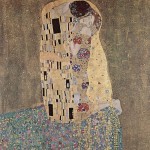 The following day was a free recovery day for the orchestra, so Dave was able to go out and about with us. We had never seen the works of Gustav Klimt at the Belvedere, so we made our way in the heat to the impressive grounds and palaces of this former residence of Prince Eugene of Savoy, a great military leader of his day.
The following day was a free recovery day for the orchestra, so Dave was able to go out and about with us. We had never seen the works of Gustav Klimt at the Belvedere, so we made our way in the heat to the impressive grounds and palaces of this former residence of Prince Eugene of Savoy, a great military leader of his day.
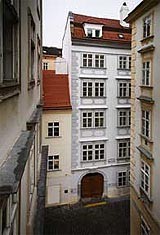 Later, we went on an evening walk with Corzoo to show him one of Mozart’s houses. I say ONE of Mozart’s houses, because he lived in many, many locations in Vienna. But this is where he lived for a longer period of time, and where he wrote the Marriage of Figaro. It was closed, but Corzoo was happy to see the narrow, modest street and lay eyes on the outside of the great master’s former abode.
Later, we went on an evening walk with Corzoo to show him one of Mozart’s houses. I say ONE of Mozart’s houses, because he lived in many, many locations in Vienna. But this is where he lived for a longer period of time, and where he wrote the Marriage of Figaro. It was closed, but Corzoo was happy to see the narrow, modest street and lay eyes on the outside of the great master’s former abode.
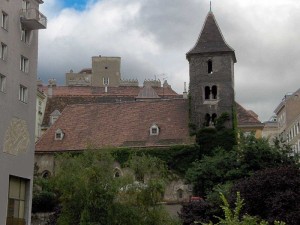 We then headed towards Ruprechtskirche, which is reportedly the oldest church in Vienna from perhaps as early as 800 A.D.! On the way there, Corzoo was reminding us of a potential pitfall of the German language. “Remember, you must distinguish between Ruprechtskirche and Ruprechtskirshe. We are going to St. Rupert’s Church, not St. Rupert’s Cherry!”
We then headed towards Ruprechtskirche, which is reportedly the oldest church in Vienna from perhaps as early as 800 A.D.! On the way there, Corzoo was reminding us of a potential pitfall of the German language. “Remember, you must distinguish between Ruprechtskirche and Ruprechtskirshe. We are going to St. Rupert’s Church, not St. Rupert’s Cherry!”
He continued with his ruminations, “I know they say that this is the oldest church in Wien, but you know there is some dispute about that now. However, documents from the 13th century do refer to it as the oldest church!”
“Well, in any case,” I replied, “I like seeing it because it is so different from so many other things we could see in Vienna. It is easy in such a great and grand city to feel overwhelmed, and this feels ancient and simple. It’s like taking a bath, don’t you think?”
“I hope not!” Corzoo protested.
When we arrived we surveyed the outside, saw what we could of the small stained glass windows, and were fortunate to find the church open for a service of some kind. We quietly slipped into the back to get a look at the place. It was a little like looking at the bones of someone who lived long ago.
We then headed towards the old Jewish quarter with its ancient winding streets and Holocaust memorial. This was the heart of the Jewish ghetto from the 13th – 15th centuries, and where Jewish life continued to thrive up until World War II. There are excavations of a medieval synagogue in the area, which we didn’t get to see since it was closed for the evening.
“Something to see next time!” Corzoo said. “But one thing that absolutely cannot wait is the Wiener Staatsoper. When are we going there?”
We could look forward to seeing the opera house of the Vienna State Opera the very next day. That night I do believe that Corzoo went to sleep with visions of Rosenkavaliers and Rhinemaidens dancing in his head.

One Response to Herzlich Willkommen!